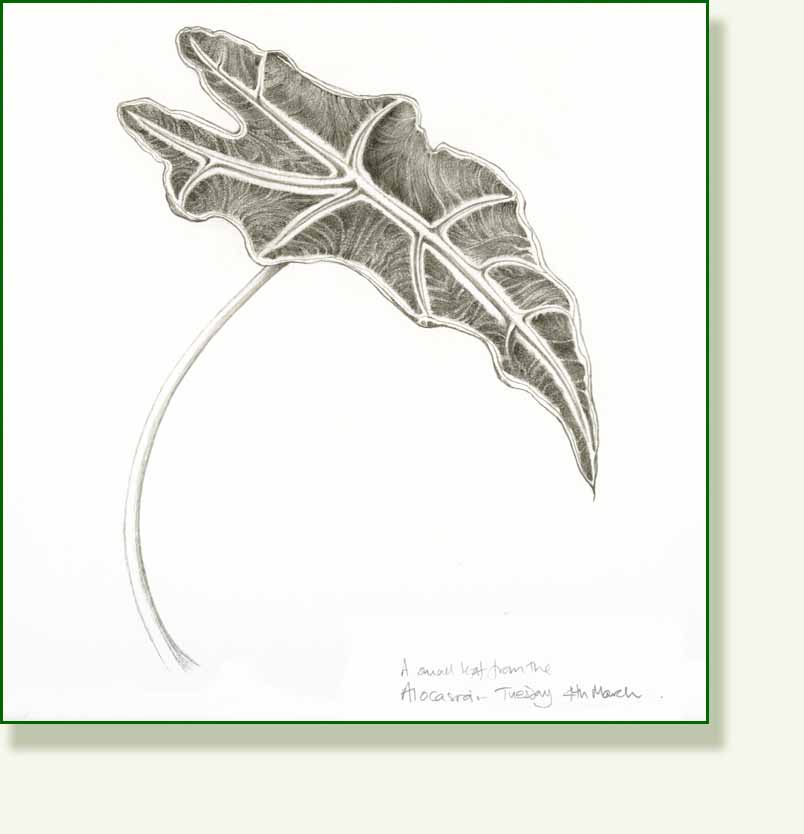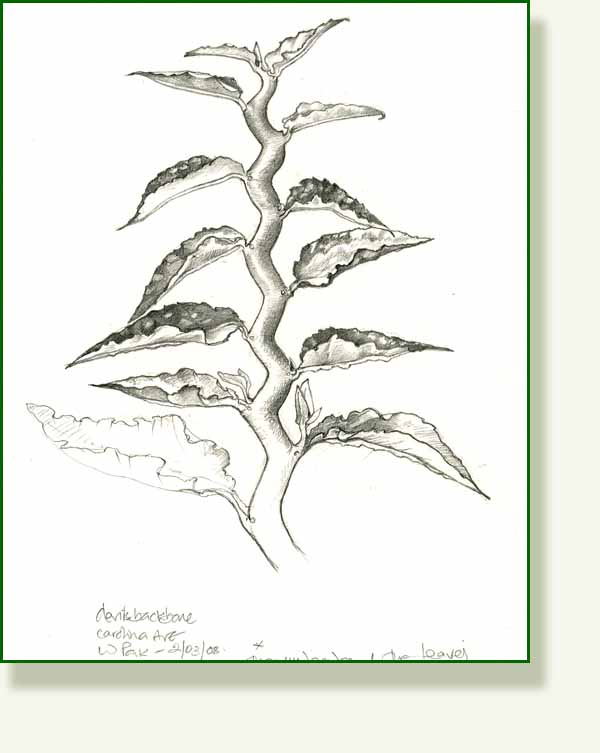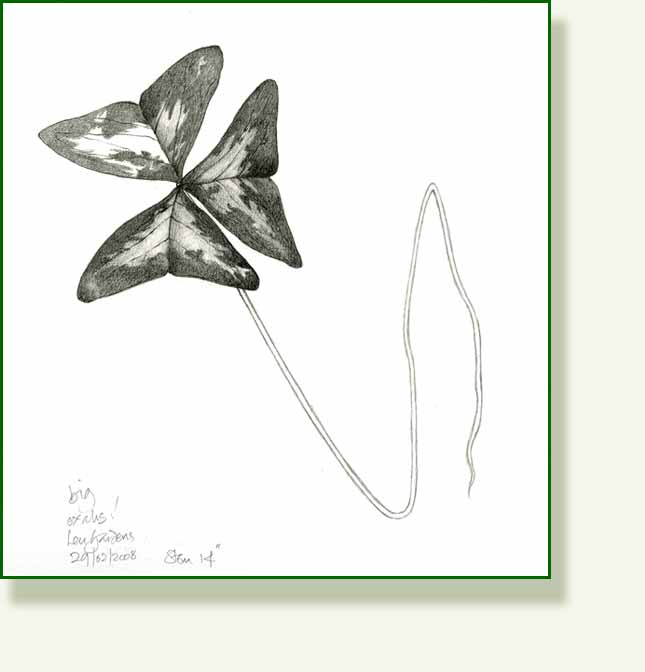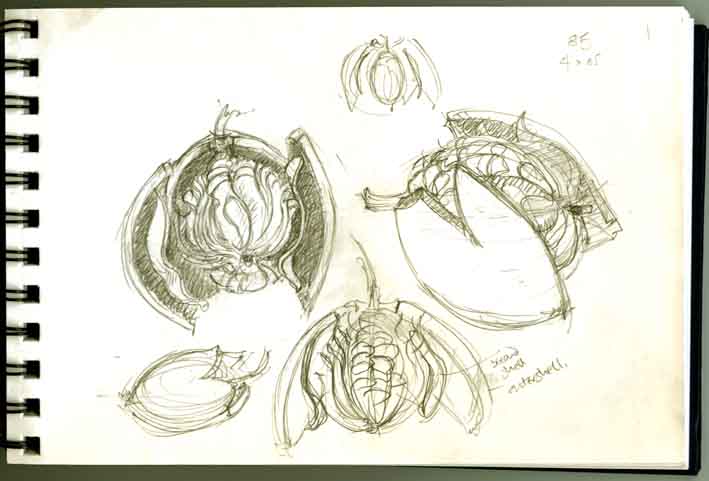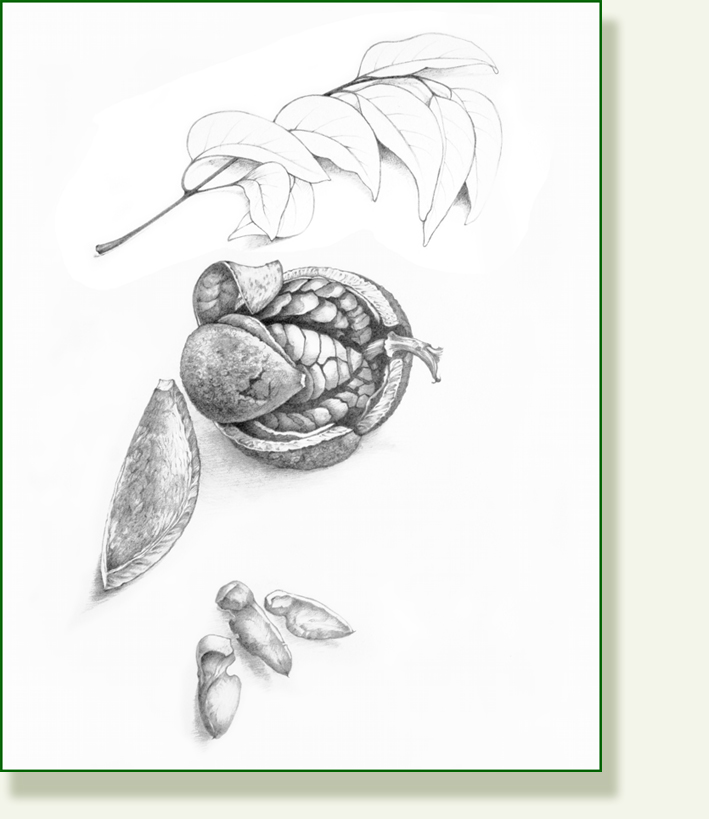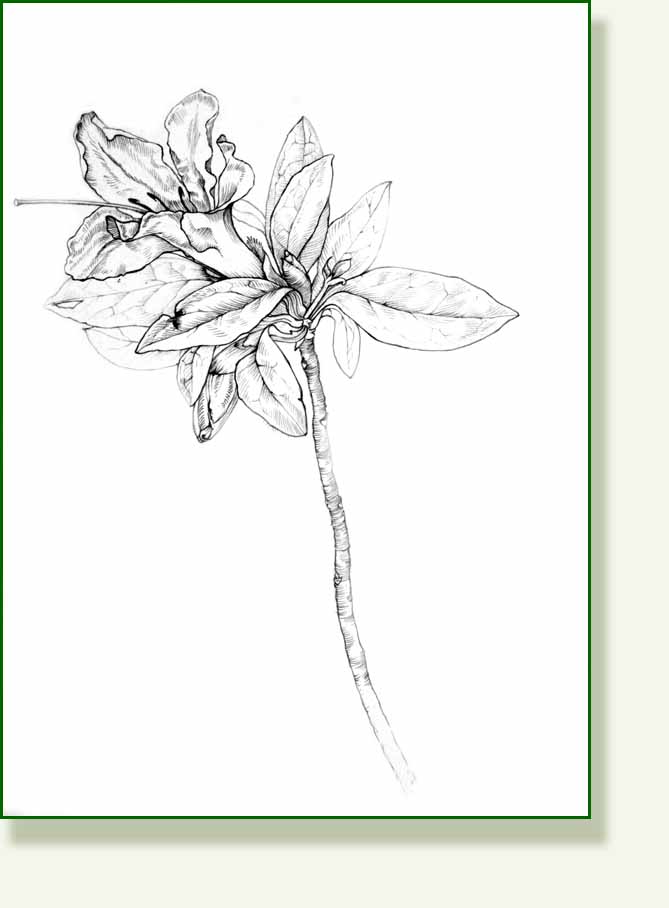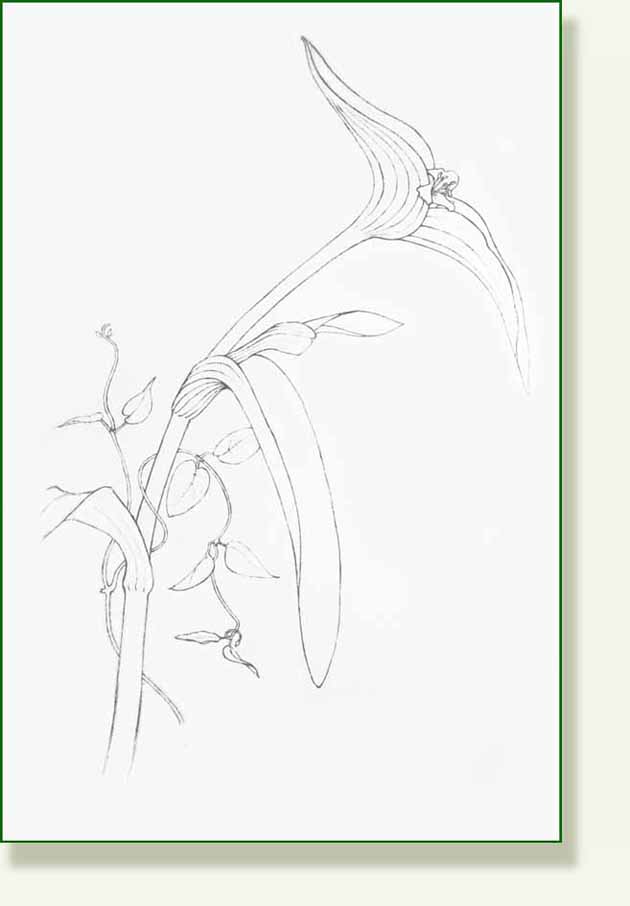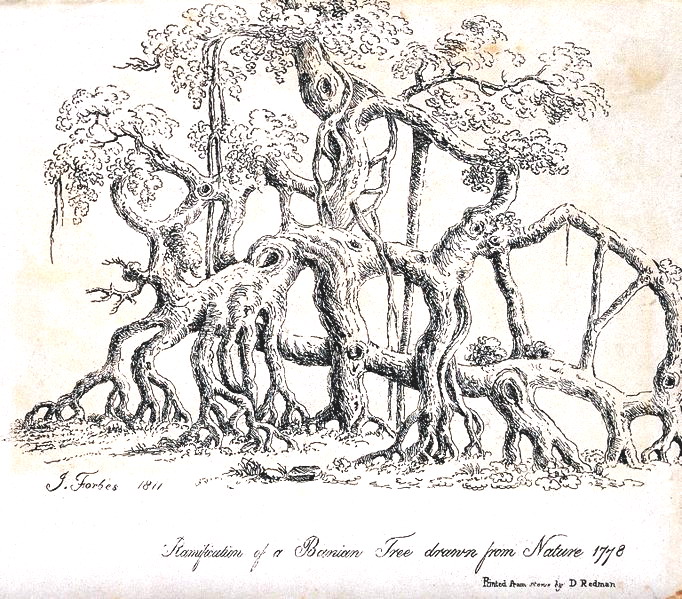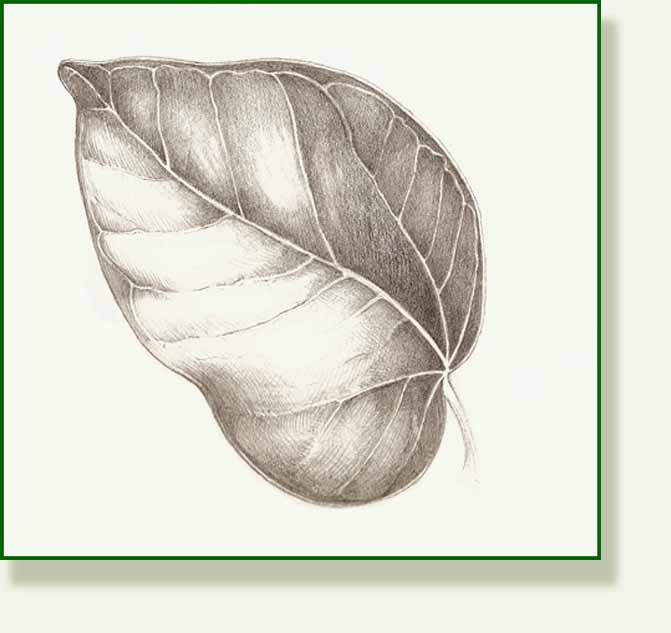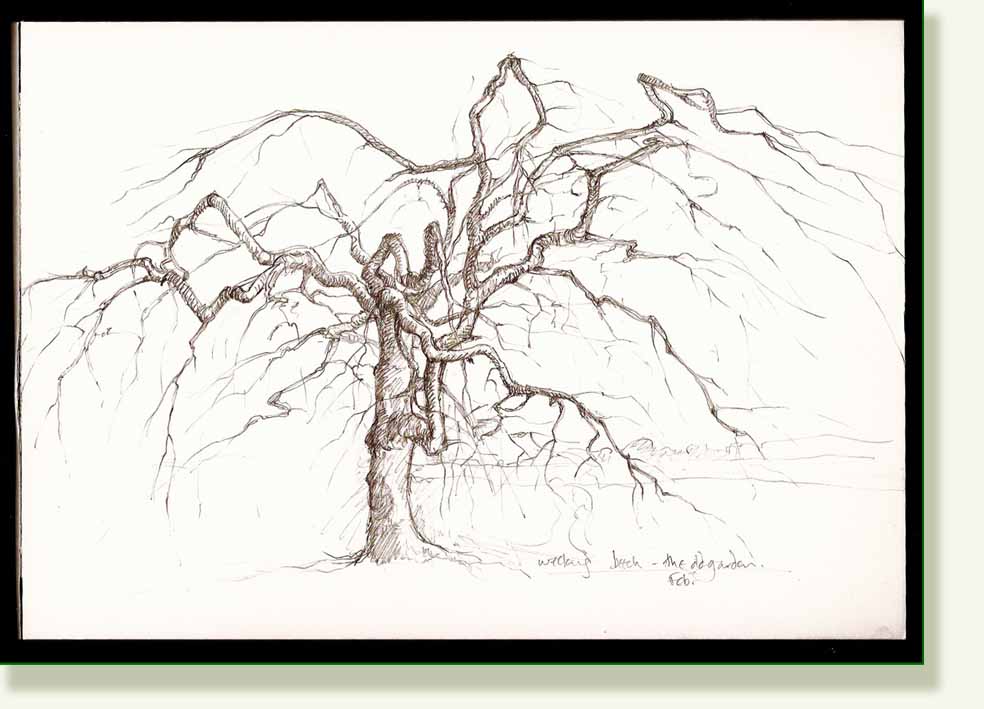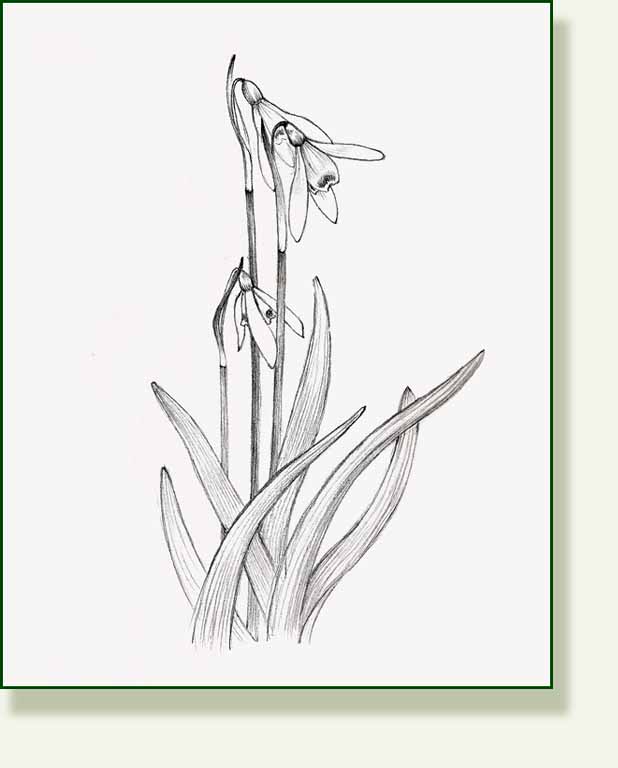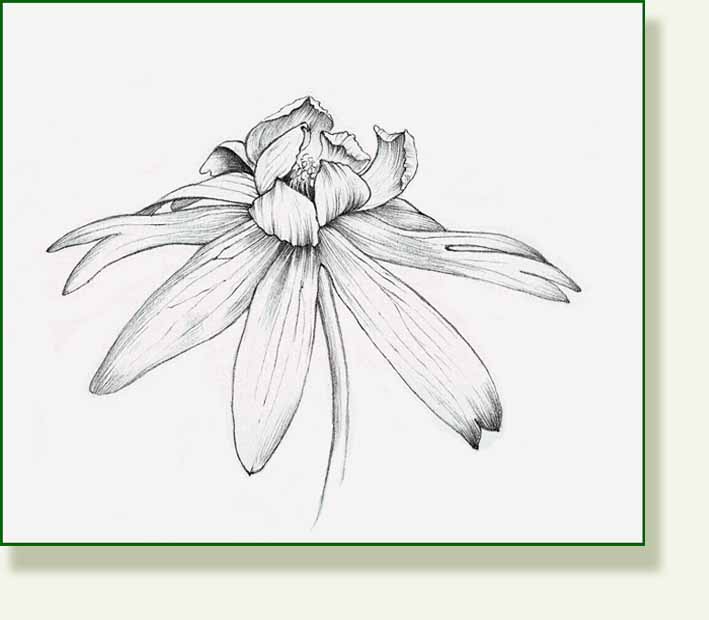I bought this beautiful elephant’s ear plant a week ago and this is probably the smallest leaf on the whole plant. It’s very handsome, dark green with pronounced white veins. I think this is alocasia amazonia but there are many different varieties and sizes. It is native to the swampy tropical areas of South-East Asia and in a favourable spot can grow huge leaves on 3 meter long stems. I am hoping this one will survive in our flat long enough at least for me to make some good drawings.
I spent most of the day out and about and have joined Winter Park Library, an excellent library, which is within cycling distance for me. They have a good section of reference books so, at last, I can identify some of the trees and flowers I see around me. I have had a seed pod now for 3 weeks, unidenfitied and therefore undrawn. I carefully went though every book on trees and plants in the bookshop across the road and spent hours trawling the internet to no avail. Thank goodness I have found out what it is… it tomorrow’s drawing.
__________________________________________
Tag: pencil drawing
Leaf of the Day: The Devil’s Backbone
What a marvellous leaf to start my March drawings with. This strange and leggy plant grows by a sidewalk tree on Carolina Road here in Winter Park. The structure of its zig-zag stem is astonishing. Pedilanthus tithymaloides has other common names; Slipper flower after its Latin name, Rick Rack plant and Red Bird Cactus because the flower resemble tiny red cardinals. I think this one has been suffering somewhat from the cold weather as many of the branches were leafless but there were one or two little scarlet flowers appearing here and there. This is another member of the euphorbia family. While trying to identify this I found it comes in different variegated colours and with different degrees of zigzag. This one has a pale green stem,the green leaves have red edges and some red patterning.
Some of the leaves themselves have have a wavy spine running under the leaf, almost like another backbone or a dragons crest.
I am hoping to achieve 5 images a week in March. Some will now be more complex and some in colour but I am reluctant to leave the pencil drawings which I am enjoying so much. There are few things that make me happier than sitting down with BBC Radio 4 some sharp green pencils and something new and beautiful to draw.
____________________________________
Leaf of the Day: Oxalis & Firsts and Lasts
The last day of February and it was a beautiful day so I went down to Leu Gardens. If only I could share the physical sense of being there, especially when I walked through the citrus garden. The overwhelming scent of orange blossom took me back to Spain and happy memories of driving through the acres of orange groves along the Guadalhorce Valley in spring. I saw many lovely flowers, trees and birds today, including lots of “firsts” for me in Florida. A comical red crested woodpecker was hammering its head enthusiastically into one of the tall palm trees, a pair of brilliant red cardinals darted in and out of the bushes and two stately woodstorks were fishing in the lake margins and then, most exciting of all, there was my first alligator!..I have to include my photo here. 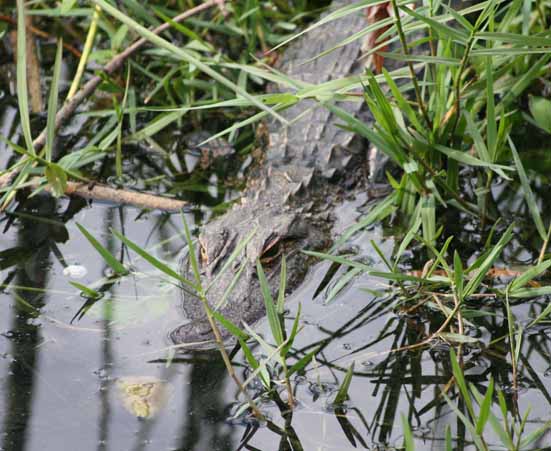
This was a small one basking in the sun with another larger one farther up the bank. It is wonderful to see them properly in the wild and not in some awful zoo doing tricks for tourists.
However back to the oxalis. There are about 800 different varieties of oxalis and this one is oxalis latifolia, or broad-leaved wood sorrel. This huge leaf was growing amongst some ornamental grasses in wooded shade by the entrance to Leu gardens. Its whole stem from leaf to root tip is 14 inches long, showing how far it had to grow to find the light. It is considered a weed here but is very pretty and they do in fact grow a beautiful dark purple variety in the gardens here.
On this trip I spoke to Pedro, one of the gardeners who drive around in golf buggies, about permission to take samples for drawing and all seems fine, I just have to ask. I am very pleased as my inspiration from the Mall borders is getting somewhat jaded. The only problem I have, is getting there on my bike. I will return to the hair raising subject of cycling in Orlando, city of cars, soon.
________________________________________
Leaf of the Day: West Indian Mahogany
I found this pod in Sarasota’s harbour-front car park while attending the course there. We had had some heavy rain and strong winds the previous day and a few of these strange pods were scattered around under the trees. I had never seen these before and was completely fascinated by their structure. Most were split open with their winged seeds spilling out onto the ground but I located a couple which were fairly intact and took them back to the hotel.
Overnight they began to dry out and open up so I dampened them down a bit, wrapped them up tightly and hoped they would survive until I got back to Orlando the following week. One of the hazards of picking things up from the ground is that they may have the odd unwanted passenger and sure enough a little earwig shot out and disappeared under the couch in the room. I really didn’t fancy spending the night with a earwig so found it fairly quickly, thankfully without having to dismantle the whole room, and popped it out of the window. I will have to remember to shake things in future!
The pods did survive but as I was making this quite detailed drawing, a week later, this particular pod began to open up alarmingly quickly and by the end of the day, was quite different, one section having fallen away completely and the seeds beginning to come away.
The mechanism of the pod is amazing. It opens up from the stem end and splits into three, then a sort of inner lining begins to buckle and pushes the outer casings farther and farther out. As this happens the winged papery seeds, which have been beautifully and compactly arranged around a central core (itself attached to the stem), begin to open out too and fall away. Quite beautiful.
The leaves are pretty too..pinnate with pairs of delicate sickle shaped leaflets. At the end of the leaf there seems to be no terminal leaflet which must be quite unusual, unless I have an odd sample. The correct term is “paripinnately compound”
I include today some sketches of the pod in its closed and open stages which I made as it opened up.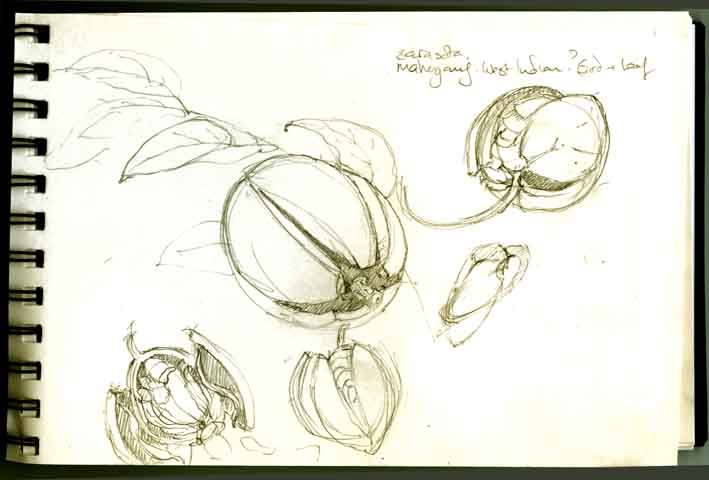
This is the mahogany tree, swietenia mahogani which was used by Chippendale and Hepplewhite in the mid-1700’s and was the original mahogany shipped back to Europe at the beginning of the 16th century. Today mahogany used for furniture is from a bigger tree, the Honduras mahogany swietenia macrophylla.
This drawing is the last for stage one of the course. From March
there will be more colour !
__________________________________________________
Leaf of the Day: Azalea
What would I do without the Mall borders? This is from the other nearby Mall. I like to vary my leaf and flower forays. It would be deemed somewhat dubious to be seen too often hanging around the Mall not only with a pair scissors.. but, worse and more suspect, without any shopping. They love to shop here.!
This little azalea is the second piece for part one of the course. It’s pencil, but shaded with hatching rather than continuous tone.
The azaleas are in full bloom everywhere now. I should get back to Leu Gardens and Kraft Gardens very soon, both were promising beautiful spring shows.
_______________________________________________
 Azalea.
Azalea.
Leaf of the Day: Tradescantia and Creeper.
The first piece for the course is a very pale outline drawing, deliberately so I hasten to add, as a precursor for watercolour painting. It was almost impossible to scan and avoid some dark shading from the paper and it does look a bit insipid here. It is from the Mall borders near Albertsons. The gardeners were weeding and thinning so this was resued from the heap of cuttings. I shudder to think what they think I am doing.. It came with this little creeper affectionately clinging on so I decided to draw both. I liked the delicate creeper against the big strong shape of the tradescantia. These tradescantia are huge Florida types..and the most gorgeous purple. This is another that will appear soon in colour.
______________________________________________
Leaf of the Day: The Banyan and Goldenrod in Fort Myers
I have recently encountered 2 amazing banyan trees. One at The Landings in Sarasota and the next one farther south at Fort Myers where Chris and I were having a weekend break. The majestic and stately banyan in Fort Myers is part of the Ford Edison estate which we visited yesterday.
This particular tree was given to Edison by Henry Firestone in 1925 as a 4 foot sapling when he, Edison and Henry Ford were pursuing the possibilities of a domestic source of rubber at the laboratory in Fort Myers. It was said to have been taken from the Great Banyan in the Shibpur Botanical garden near Calcutta the largest Banyan in the world.
The history and growing habits of the banyan (Ficus bengalensis) are completely fascinating and it is a botanical wonder. The tree starts life as an epiphyte, settling on the branch or bark crevice of another tree. It gradually takes over from its host by producing aerial roots and, once established, auxiliary roots sprout from the branches like long strands of spaghetti. The tree must somehow sense the need for more support and these become supportive trunks necessary to prop up its massive spreading horizontal limbs and so it spreads, on and on .. “walking” its way across huge areas of ground.
In an HGTV article on the Banyan, Bob McGuire explains the effects of the tree!!!
“Bob McGuire, chief arborist at the Thomas Edison Estate, counts the prop roots of the Edison banyan and finds there are 323.
“Visitors touch the roots and they talk to them,” McGuire says. “People are awestruck by the tree. You can tell by their faces. And you know, we still are too. I’m still in awe of it every day.”
There are many other interesting plants and trees to see at the estate set on the banks of the Caloosahatchee River.
W. Stoker, D. Redman after James Forbes., 1811
A few words from Milton:
“The fig-tree at this day to Indians known
In Malabar or Deccan, spreads her arms,
Branching so broad and long, that on the ground
The bended twigs take root, and daughters grow
About the mother tree, a pillar’d shade,
High over-arched and echoing walks between.”
Milton “Paradise Lost”
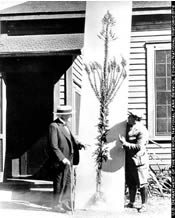 The tree was found not to be able to produce rubber in Florida however and Edison then turned his incredible mind and boundless energy to finding another source. He discovered the lovely autumn flowering Goldenrod was capable of producing rubber and there is a huge dried specimen in the laboratory at the museum which Edison had bred for commercial rubber production.
The tree was found not to be able to produce rubber in Florida however and Edison then turned his incredible mind and boundless energy to finding another source. He discovered the lovely autumn flowering Goldenrod was capable of producing rubber and there is a huge dried specimen in the laboratory at the museum which Edison had bred for commercial rubber production.
There is a short informative article about him here. and the link to the Museum site in Fort Myers is here
The lab visit alone is worth the price of entry.
________________________________________________
Leafless of the day: Weeping Beech
I am now back in Orlando very briefly before going to Sarasota tomorrow for a course, but have a few posts still to make of the winter Lincolnshire landscape where the deciduous trees show off their beautiful tracery of branches. This sketch is of the magnificent weeping beech in our old garden. The spread of this tree is immense..much more than the drawing suggests.. as you can see I ran out of room on the paper.
Its twisting branches rear up and fall again in long searching fingers with a million fine stems falling to the ground. In the summer the tumbling leaves obscure the main trunk and clothe most of the lower branches, but the tops of the branches are always visible, I used to think they were like huge bony hands holding up skirts of wind blown swaying leaves. It is very beautiful.
________________________________________________
Leaf of the Day: Snowdrop
No spring garden is complete without snowdrops. Here is a sketch of three from under one of the apple trees. As I am in Tennyson country I feel I should favour his snowdrop poem.. simple and optimistic. It was written late in his life in 1889.
February fair-maid,
Ever as of old time,
Solitary firstling,
Coming in the cold time,
Prophet of the gay time,
Prophet of the May time,
Prophet of the roses,
Many, many welcomes,
February fair-maid! Alfred Lord Tenyson
Leaf of the Day: Aconite
An aconite from under the weeping ash tree. They are so pretty and dainty with their green fringe and glossy yellow petals. Locally they are known as “choirboys “, an innocent and charming image, but like the hellebore from yesterday they are poisonous. Their root is similar to Horseradish and that confusion had added a deadly zest to some roast beef in the past.
The Latin name is “Eranthis hyemalis” and together with the hellebore they are part of the ranunculus genus..buttercups.
__________________________________________


